Canadian Pacific Water Facilities in the Ottawa - Smiths Falls Area
These notes have been prepared by Andrew Jeanes and Colin Churcher with input from many members of the Ottawa Railway History Circle| Chalk River subdivision | ||
| Smiths Falls | See Winchester subdivision | |
| Franktown | See Smiths Falls (in Winchester sub) | |
| Carleton Place | 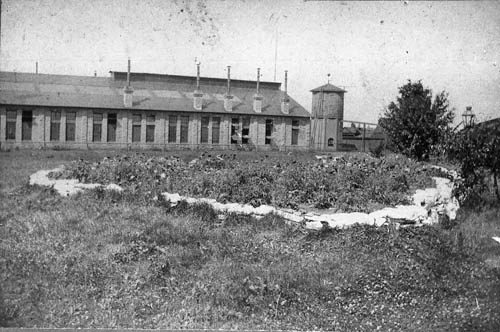 Part of CPR shops at Carleton Place about 1895-1900 showing old water tank in front of shops. Matt-6222 | 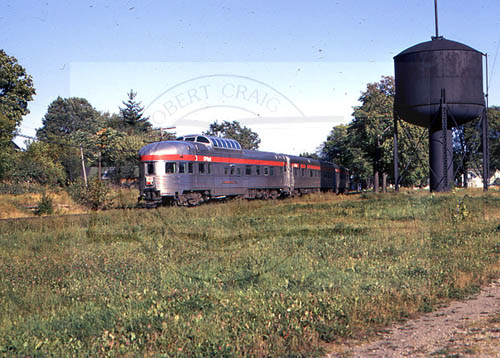 Gary Armstrong Collection, CRCML 60,000 gal. all-steel (2nd?) "A water tank of 60,000 gals. capacity will be built at Carleton Place." (Canadian Railway and Marine World, Apr 1926 p174) |
| Almonte Gazette 14 December 1894
When the large tank in the C.P.R.yard here was being cleaned out some
weeks ago, three well developed fish, each five or six inches long.
Were found. The peciliar part of the find is that they must have passed
through the pump when quite small and developed in the tank, as they
could get in no other way. They were quite healthy. - Carleton Place
Herald. |
||
| Almonte | Almonte Gazette 30 June 1871.
WIND MILL. – A windmill has recently been placed on the tank in this
place by the B. & O. R. Co., for the purpose of raising water to
the cistern. An immense amount of manual labor will be saved by thus
utilizing the airy element. Perth Courier 3 April 1868. (excerpt from B&O annual report for 1867) …the tank-houses at Bellamy’s and Almonte were destroyed by fire, and had to be rebuilt Almonte Gazette 30 June 1871. WIND MILL. – A windmill has recently been placed on the tank in this place by the B. & O. R. Co., for the purpose of raising water to the cistern. An immense amount of manual labor will be saved by thus utilizing the airy element. Almonte Gazette 29 March 1889. The C.P.R. tank-house here will shortly be torn down and a new one erected near the station. Work is now going on Also See entry for Pakenham Almonte Gazette 4 July 1890. The Almonte tank-house will be removed to Pakenham. Almonte Gazette 22 August 1890 The C.P.R. tank-house here took fire last Friday and was blazing up in a dangerous manner for a time; but the employees managed to put it out with a few pails of water. Almonte Gazette 28 November 1890. The C.P.R., we understand, will shortly do away with the tank here, having built in its place a large one at Pakenham which will hold about 50,000 gallons of water. Almonte Gazette 13 March 1891. The pumping machinery has been removed from the old C.P.R. tank here. | |
| Pakenham | Almonte Gazette 19 September 1890.
PAKENHAM NEWS. A TANK HERE. - The C.P.R. Co. are erecting a water tank
near the station here.The water will be drawn from the river and pumped
into the tank by steam power. Renfrew Mercury 5 December 1890. The C.P.R. will shortly do away with the tank at Almonte, having built in its place a large one at Pakenham that will hold 50,000 gallons of water. Arnprior Chronicle 5 December 1890. The Canadian Pacific Railway has built a new water tank at Pakenham, with a capacity of 50,000 gallons. The tank at Almonte will be taken down. Almonte Gazette 5 December 1890. PAKENHAM NEWS. COMPLETED. - the CPR water tank is now finished, and seems to be a substantial affair. It is said to be the largest on the line. The boiler and engine in connection with it have also been placed in position. The engine house is at the west end of the iron bridge, and the water is conducted through pipes which have been laid from the river to the tank. The pipes are securely imbedded in the clay on the south side of the track. The laying of a platform from the tank to the station has made a great improvement. Almonte Gazette 4 May 1894 On Monday last (30 April) Mr. John Beaton, who has been tank-man for the C.P.R here, received notice that his duties woiuld be performed by the baggage-master at the station. As Mr. Beaton has purchased property and spent considerable means on improving it, the action of the C/P/R. places him in a awkward position. | |
| Arnprior | From Brian Gilhuly
A temporary tank was erected east of the Madawaska late in 1864, when
that was the northern terminus of the Brockville and Ottawa. It was replaced in 1865 by a permanent tank almost certainly adjacent to the crossing of a creek just east of the Flat Rapids Road (now Daniel Street) and two blocks east of the station at the foot of Hugh Street. The tank is not shown on early maps, but the creek is the only surface water source within the r-o-w in town. The CPR in 1899 built a new station a half-block closer, and converted the old station to a freight shed, but there is no mention of any change to the tank. In 1900, Arnprior’s municipal water system began operation. Renfrew Mercury 7 October 1910 The C.P.R. has offered the town of Arnprior $500 for a water service for their engines. If an arrangement can be made the tanks at Pakenham and Sand Point will be abolished Arnprior Chronicle 16 February 1912. The agreement between the town and the C.P.R. regarding the supply of water for the company’s locomotives was read and on motion of Dr. Cranston a bylaw was passed ratifying the agreement and authorizing the fixing of the corporate seal thereto. From Brian Gilhuly Connection to the town mains required that the tank occupy a new location a block to the west so that it could be connected to the John Street main by a two-inch supply pipe. The tank was set well back from the tracks and fed a standpipe. An octagonal tank at that location is visible in aerial photo HA525_052, taken on 9 November1927. Arnprior Chronicle 21 March 1930. From the C.P.R. came a request for a four-inch pipe rather than a two inch, as at present, at the local water tank, this in view of the fact that the Renfrew tank will be out of commission for a time during the coming summer and for that period the Arnprior service will be used more. Council placed the communication aside until further information is secured. Arnprior Chronicle 18 April 1930. COUNCIL REFUSES TO INSTAL (sic) A LARGER PIPE FOR C.P.R. TANK Mr. Castleman, a C.P.R. engineer addressed a regular meeting of the municipal council on Thursday evening of last week in support of a request from the railroad that the town sanction the replacing of the present two-inch feeder pipe to the C.P.R. gravity tank on John street with a four-inch pipe. Council re-affirmed a former decision that it would not alter the present status quo. [details of discussion followed] Arnprior Chronicle 15 September 1932. From the C.P.R. came a request to change, from a two-inch to a four-inch, the pipe which taps the John street main to supply water to the railroad tank on that street. The same request had been presented to a previous council without results. On Thursday night, some councilors were favorably disposed toward the request; others were strongly opposed, hence the matter was referred to the waterworks committee who will bring in a report at a future meeting. From Brian Gilhuly There is no newspaper account of the committee’s report, but I believe the subsequent contract included the size change. I will be able to verify from council minutes once I can get at them. Arnprior Chronicle 26 January 1933. Previous to dealing with the matter of wage reductions, council … authorized the signing of an agreement to provide water to the pump stand at the C.P.R. station for the next five years. [table of rates followed] Arnprior Chronicle 25 November 1937. The C.P.R. contract for water supply was renewed for another five years Underwriters Fire Plan 1950 shows a steel tank with four-inch connection in place. No tank is shown on earlier fire plans. | |
 Crop of HA525-052 |  40,000 gal. enclosed octagonal, built 1911 Matt-3844 | |
| Sand Point | Ottawa Free Press 11 December 1879
The Canada Central Railway have constructed a new water tank at Sand
Point. The water is pumped from the lake by a powerful engine. Aylmer Gazette 10 December 1880 The C.C.R Co. have built a new water tank at the station at Sand Point. The water is forced up from the lake by a powerful engine. | 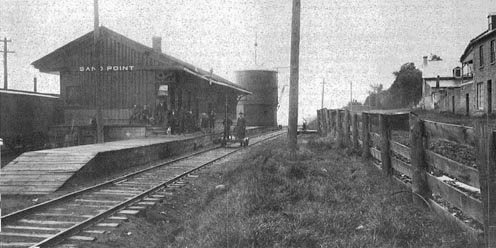 This is copied from a scanned issue of Canadian Rail (No. 409 Mar-Apr 1989 p63) but is credited to the CP Corporate Archives. The water tank at Sand Point likely in the 1890s. |
| Renfrew | Renfrew Mercury 14 November 1879 The foundation is about completed for the new engine house which will be large enough to hold three engines at one time. The turning table, instead of being replaced at the former point, is being erected on the site where Halpenny's smaller shed stood, on the village side of the track. Further east, a tank of large dimensions is being constructed, and it is proposed to erect a wind mill for pumping the water to the road. Almonte Gazette 11 November 1891 The building coverning the tank on the C.P.R., about a mile and a half below the town, was set on fire by a passing engine about ten days ago. The fire took place through the night when no person was around and was making good progress when another train came along. The train was stopped and the men set to work and put out the fire - Renfrew Mercury. Renfrew Mercury 17 February 1893 Mr. H.B. Spencer, assistant superintendent of this division of the C.P.R. was in town on Monday, and had an interview with Mr. A.A. Wright, asking him to furnish an estimate of what he would charge to supply water from his well at the elevator for a tank which the Company proposes to build soon at the Renfrew station. The tank will probably be built near the elevator: and a pipe will then be run down east of the K. & P.R. station: so that the engines can be filled with water at either end of the yard. In this way no time will be wasted with passenger trains. If Mr. Wright does not feel sure of being able to guarantee a sufficient supply of water, the company will run a pipe to the river Renfrew Mercury 20 January 1899 The C.P.R. tried their water crane for filling their engines at the station from the waterworks system on Monday and Tuesday. It is not the crane of usual pattern, but one of experimental character; and, as it caused a very severe shock to the pipe system, the gauge flying from zero to 200 lbs. on Monday and 150 lbs. on Tuesday, the committee caused the water to be shut off until some better machine was provided. The K. & P.R. crane is fitted with a slow screw valve, and its effect upon the pressure is hardly noticeable. Renfrew Mercury 10 March 1899 Two mechanical experts in the C.P.R. works in Montreal were not satisfied with the tests made of the water taking apparatus put in at the station here in connection with the town waterworks system, and which had been condemned by the waterworks committee as putting too great a strain on the pipes. Two of them, Messrs. Horsey and Fulton, visited town on Wednesday and superintended another test; but again the gauges jumped from 50 to zero and then to 100 lbs. pressure as the water was turned on and off again. Renfrew Mercury 14 April 1899 The C.P.R. this week erected another crane for taking water for their engines, at the station here, from the town waterworks system. This one is operated with a screw valve, and does not exert such a jerk on the piping. With one or two slight changes it is probable that this crane will be accepted by the waterworks committee and the taking of water here will begin Renfrew Mercury10 August 1900 The C.P.R water tanks at the station here are now under construction. There are to be two - one at each end of the station platform so that the fast trains will lose no time, in which ever direction they may be going: but will take water while loading and unloading passengers and baggage. Renfrew Mercury 17 August 1900. The Mercury was not quite correct about the C.P.R. water tanks at Renfrew station. There are not to be two tanks, as stated, but from the one which is being built at the south-east end of the station, a pipe will be run underground to the other end of the yard, where will be erected, not another tank, but a crane similar to that now in use, which will be used for filing the engines with water. The stone foundation of the east-end tank is now about completed. It rises nineteen feet above the ground, and on steel girders built into it will be placed the tank, which will hold 40,000 gallons. Renfrew Mercury 26 October 1900. The C.P.R. tank is nearing completion. The stone foundation, 19 feet high, was finished some time ago, and now the tank proper is ready for the water to be turned on. The tank is built of British Columbia cedar, in narrow strips, three inches thick, and coated inside with pitch. Renfrew Mercury 28 April 1905 The C.P.R. is also fitting up the watering cranes at the station with larger piping; so that two minutes may be saved in the time of trains taking water. | |
 Stone masonry base. Brian Ludlow photo | ||
| Haleys? | The 1912 employee timetable for the Chalk River Sub has a location called “Water Tank” just over a mile east of Cobden. Logically, there is a water tank there. This may be the same location as the "Haley’s" tank. | |
| Meath? | ||
| Cobden | Almonte Gazette 12 July 1901 The C.P.R. tank about a mile east of Cobden was destroyed by fire last week. Renfrew Mercury 28 Febraury 1902. Cobden Sun. Some weeks ago the C.P.R. put a gang of men at work digging a well immediately north of the tank on the west side of the yard here. They sank the shaft about twenty feet and then abandoned their job. So great is the need of a greater water supply here that another gang of ten laborers went to work on Friday afternoon last with instructions to sink the shaft an additional eighteen feet. Whether or not a well of the dimensions of the one at present being dug will supply water in sufficient quantities to meet the demand cannot yet be stated, but the well will serve a good purpose if it will supply engines during the winter. The scarcity of water here is a distinct loss of money for the company. Nearly every day trains are stalled on the siding while the engines run to Renfrew to get water and return. A few days ago no less than five engineers found themselves in this predicament and had to run to Renfrew while their trains remained in the yard here. Had they been able to get water here the probability is that the trains would have reached Ottawa at the time they were prepared to pull out of Cobden Renfrew Mercury 24 July 1902. The C.P.R. has commenced the erection of a water tank, to hold 50,000 gallons, at Gould's creek near Cobden. The Suns says a rumor, the accuracy of which cannot be guaranteed, to the effect that the new spur, which will connect the main line of the C.P.R. with the P.P.J., will leave the transcontinental main line in the vicinity of Gould's creek and it is with this contingency in view that the tank is being constructed on this site.The rumor was brought to town by a Montreal traveller who stated that he heard it in Montreal and Ottawa. The action of the C.P.R. in building the tank so far away from the station seems to bear out the statement. Men who know the country between here and what is known as Split Rock on the Quebec side of the Ottawa, say there is an admirable route between the two points which could be utilized by the railway company at a minimum of expense | |
| Pembroke | Almonte Gazette 1 September 1893.
The C.P.R. will pay Pembroke the sum of $600 per annum for
supplying water from the water works for their engines and station at
that town. Repeated verbatim in the The Equity, Shawville, 7 September 1893 |  All steel. John Frayne collection CRCML |
Chalk River | 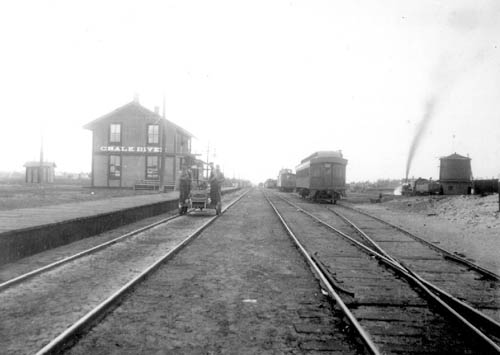 (Probably a Heckman photo, http://www.virtualmuseum.ca/sgc-cms/ histoires_de_chez_nous-community_stories /pm_v2.php?id=record_detail&fl=0&lg=English&ex=00000311&rd=243279#) | 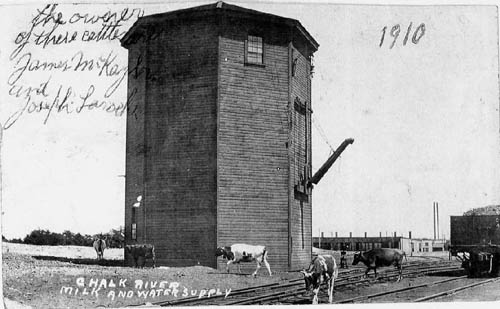 Enclosed octagonal (http://www.virtualmuseum.ca/sgc-cms/ histoires_de_chez_nous-community _stories/pm_v2.php?id=record_detail&fl=0&lg=English&ex=00000311&rd=243282#) |
 All Steel (http://www.virtualmuseum.ca/sgc-cms/ histoires_de_chez_nous-community_stories/ pm_v2.php?id=record_detail&fl=0&lg=English&ex=00000311&rd=243325#) | Photo from the collection of a Fred Shannon and taken in 1956. From Bruce Chapman Chalk River Watering Facilities; 2 heavy Mikados doubleheading west over the Deux Rivieres grade to North Bay, and one standard Hudson heading east. From Tony Humphrey Now Bruce this is looking west, my early trips to RV the shop was still standing and there was a yard engine on from 1600 till midnight. They had a sweetheart deal with the company that the engineer would work one week and the fireman the next. If I remember correctly there was a wye located behind the shop. There were still ties in the ground on the south side of the main line but the rail had all been lifted. At the east end of the yard there was a spring switch, one of two on the RV sub. There were two main lines, the old main line and the "new" main line. | |
Updated 1 May 2024
Home Main Findings Page CPR Water Facilities Page
